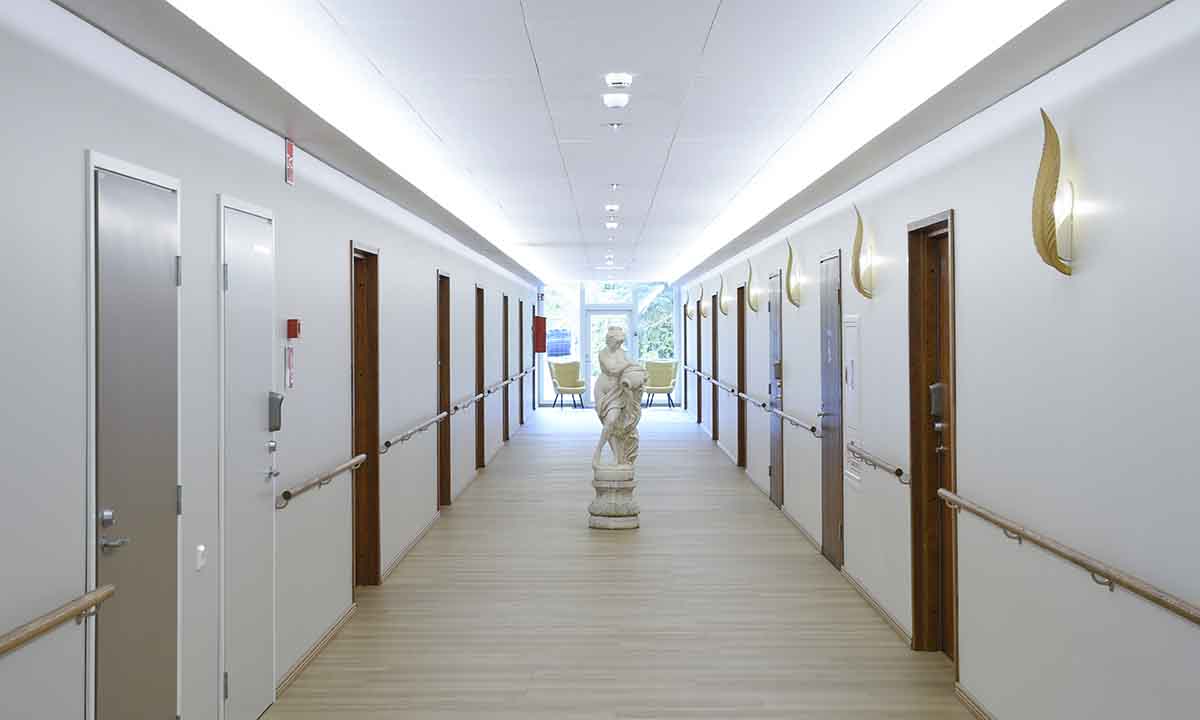
Senior Hotell Ainola
Mäluhäired mõjutavad inimese võimet tõlgendada nii oma füüsilist kui ka akustilist keskkonda. Sel aastal valminud Senior Hotell Ainola pakub rahulikku helimaastikku, mis oli projekti võtmeaspekt algusest peale.
Loe lisaks (inglise keeles).
Connected to care home Villa Tapiola in Espoo, the new extension, Senior Hotel Ainola, was completed in 2019 and offers short-term accommodation intended in particular for those with memory disorders. Ainola, spanning 650 square metres, has private rooms for 14 residents, as well as large lounge and common spaces for residents to spend time in.
The home-like environment offers those with memory disorders a safe, secure and pleasant everyday life.
“We wanted to offer our guests modern spaces combining comfort with a sense of security. Both Villa Tapiola and Ainola are designed around the needs of those with memory disorders,” explains Villa Tapiola Director Tuula Laulaja.
Based on 40 years of working with those with memory disorders, Laulaja believes there is a need for short-term residential units like Ainola. For example, Ainola makes everyday life easier for informal carers by offering first-rate care and accommodation for anything from a few hours to a few weeks.
A good living environment promotes the wellbeing of those with memory disorders
The starting point for the design work was creating clear and open spaces in which it would be easy to move around. Best practices and solutions have been developed based on experience.

“In designing the new spaces, we made use of our years of experience working with those with memory disorders. Space solutions support the comfort of those with such disorders, as well as offering a home-like living environment and safe, obstacle-free mobility,” explains Architectural Designer Pirjo Huvila. She was involved in the design of Villa Tapiola 15 years ago, and was responsible for the material choices, furniture procurements and acoustic solutions for the new facilities. Architect Anna-Maarit Reijonen served as the lead designer for the project.
Memory disorders influence a person’s ability to understand or observe their surroundings. A clear colour scheme and indirect lighting support residents with perception difficulties.
“For example, the flooring surfaces must be uniform in their colouring, as those with memory disorders that involve perception issues can interpret darker spaces as holes and be afraid of falling. There must be a sufficient contrast between the colours used, so that doors and handrails stand out well against the wall surface,” explains Huvila.
The acoustic environment plays a big role in the wellbeing and everyday lives of those with memory disorders. According to research, when it comes to the senses, hearing has the biggest impact on the quality of life of people with memory disorders. Excessive hustle, bustle and noise can cause a person to feel unsafe, anxious and tired, whilst a calm sound environment makes it easier to establish and maintain contact between clients and carers.
“Those with memory disorders can become frightened if they feel they are in a strange environment. The acoustic environment should sound as familiar as possible, and strange sounds should be minimised,” states Huvila.
One particular obstacle for the acoustics at Ainola was the hard surfaces required to aid accessibility. Ainola’s acoustic solutions can be found simply by looking up; Ecophon’s Master Ds tiles have been used on the ceilings of the lounge spaces and corridors, whilst suspended Solo Circle acoustic panels were used in the common areas.
A cosy and safe everyday life
The shared goal of the designers and customer was to create cosy and comfortable spaces for Ainola, which would support the wellbeing of those with memory disorders. It is safe to say that this goal has also been achieved.
“The end result we have created successfully combines accessibility and comfort, and rather than feeling institutional, the spaces feel cosy,” states Huvila. One example here are the spacious hotel rooms, decorated in lighter shades, where the only elements indicating that the residents may have additional needs are solutions to promote patient safety and accessibility, such as safety railings and motorised beds.
When it comes to creating a comfortable environment, it is important to ensure a calm acoustic environment in the spaces. Factors influencing the acoustic environment include the different functions of the building and their acoustic requirements, which were taken into account right from the architectural design stage.
“To give you an example, the accommodation spaces have been positioned in such a way that they are separated from the living areas. This gives us a calmer part of the building for rest, and correspondingly, a space where the sounds of everyday life and the hum of voices will not disturb others,” Huvila continues.
Particular attention has been paid to acoustics in shared spaces where people will be eating, playing games and reading newspapers at the same time. According to Laulaja, the staff also notice the difference good acoustics make.
“When you step inside, you leave other noise behind and it calms your mind.”
This article is a free translation of an original text in Finnish by Eveliina Miettunen. Find it here.
